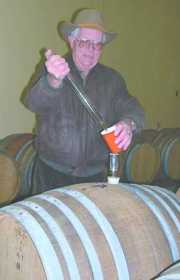New winery readies for spring vintage

April showers bring May flowers, so the adage goes. But one Hammett couple is hoping this April will produce a different kind of bouquet--one that is as pleasing to the palate as it is to the nose and eye.
Bill and Bing Ringert are looking forward to the opening of their Cold Springs Winery this April. That opening is contingent on whether the Chardonnay, at present aging in an oak barrel, is ready for bottling, Bill explained.
Several wine varieties are in various stages of fermentation at the winery, including chardonnay, riesling and merlot. Wines processed at the facility are the end result of grapes grown on a 12-acre plot of land that gently slopes away from the Ringert's hilltop home just north of Hammett. Varieties grown in the vineyard include riesling, chardonnay, viognier (all white wine varieties) and the red wine grapes of cabernet sauvignon, merlot, syrah and pinot noir.
Amidst the vines, a 68x40 square-foot building, provides ample space for producing 10,000 cases of wine each year. That's the ultimate goal. This year, Bill hopes the winery will produce at least 600 cases. The building also houses a lab, tasting room and sales area. Plans for an underground wine cellar are underway. Jamie Martin, owner of the Rose Creek Winery in Hagerman, now closed, will oversee production at Cold Springs Winery.
The process of wine making begins with the harvest, sometime in late summer or early fall. After the grapes are crushed the juice is either pumped directly into fermentation vats (for whites) or left to mingle with the skins to produce the rich red varieties. At some point, yeast and sugar is added. The wine will be finished in aged oak barrels. Made in France, barrels for Cold Springs Winery were garnered from a cellar in California's Napa Valley, a region noted for its premier wines.
Soil and climate are essential to growing high quality wine grapes, Bill explained. He believes the blown volcanic ash soil indigenous to Hammett is ideal because its porosity forces roots to grow deep in search of beneficial nutrients. While the area's climate can be fickle -- about two-thirds of Ringert's 2003 crop was damaged by a late frost -- Bill still believes Hammett has the potential for producing excellent fruit. "Here in the Snake River Valley our elevation is as high as any" other wine grape producing region, which Bill believes should not stand as a barrier to growing quality wine grapes.
An experimental plot on the Grindstone Butte Project, which Ringert co-owns with his brother, is being tested to determine whether that area is favorable for growing wine grapes. Bill was told that the area's elevation was too high and the first experimental planting did not fare well, said Bill. Several factors may have contributed to the crop failure including a late planting and plant stress, he explained. Undaunted by the disappointment, Bill has plans to replant the area this spring.
Bing, a silent partner in the venture, lends her support to the project, Bill said. And, like Bill, enjoys sampling the wines for palatability. In fact, Bill says he has no shortage of people willing to sample the winery's product.
So, why start a winery in an obscure little town in Southern Idaho?
Bill, who was raised on a farm in Castleford, believes that growers receive the greatest return on their crop if they can see it all the way to market. He said he has "done about as much as one can" with potatoes, which are grown on the Grindstone Butte Project and on some acreage below the existing vineyard. Besides, he likes wine!
A fact-finding/pleasure tour of the French, German and Italian wine regions in 1998 and triggered a budding interest in planting vines indigenous to some of those regions. Bill said he couldn't decide which region produced the best wine. "Every country that produces grapes has a range of good to bad wines," he noted." Much of the tour was spent in the Provence region of France. "I suppose, subliminally, we were steered toward the French wines," but the wine was also good in Germany and Italy, he was quick to note.
This spring, 23 acres adjacent to the existing vineyard will be planted with grapes indigenous to some of the areas they visited, bringing the total number of acres under production to 35.
The $500,000 investment -- give or take a few dollars -- sometimes makes Bill shudder. But he has no doubt that Idaho's budding wine industry can "compete with anybody in the world." The Ringert's winery should produce about 10,000 bottles of wine each year. About 2/3 of the grapes will be grown on-site. The remainder will be bought from other growers.
After 35 years as an attorney and six years on the state senate, Bill has gladly returned to his rural roots. Today, he and Bing are ready for a quieter life among the vines, sipping wine and enjoying the fruits of their labor.
